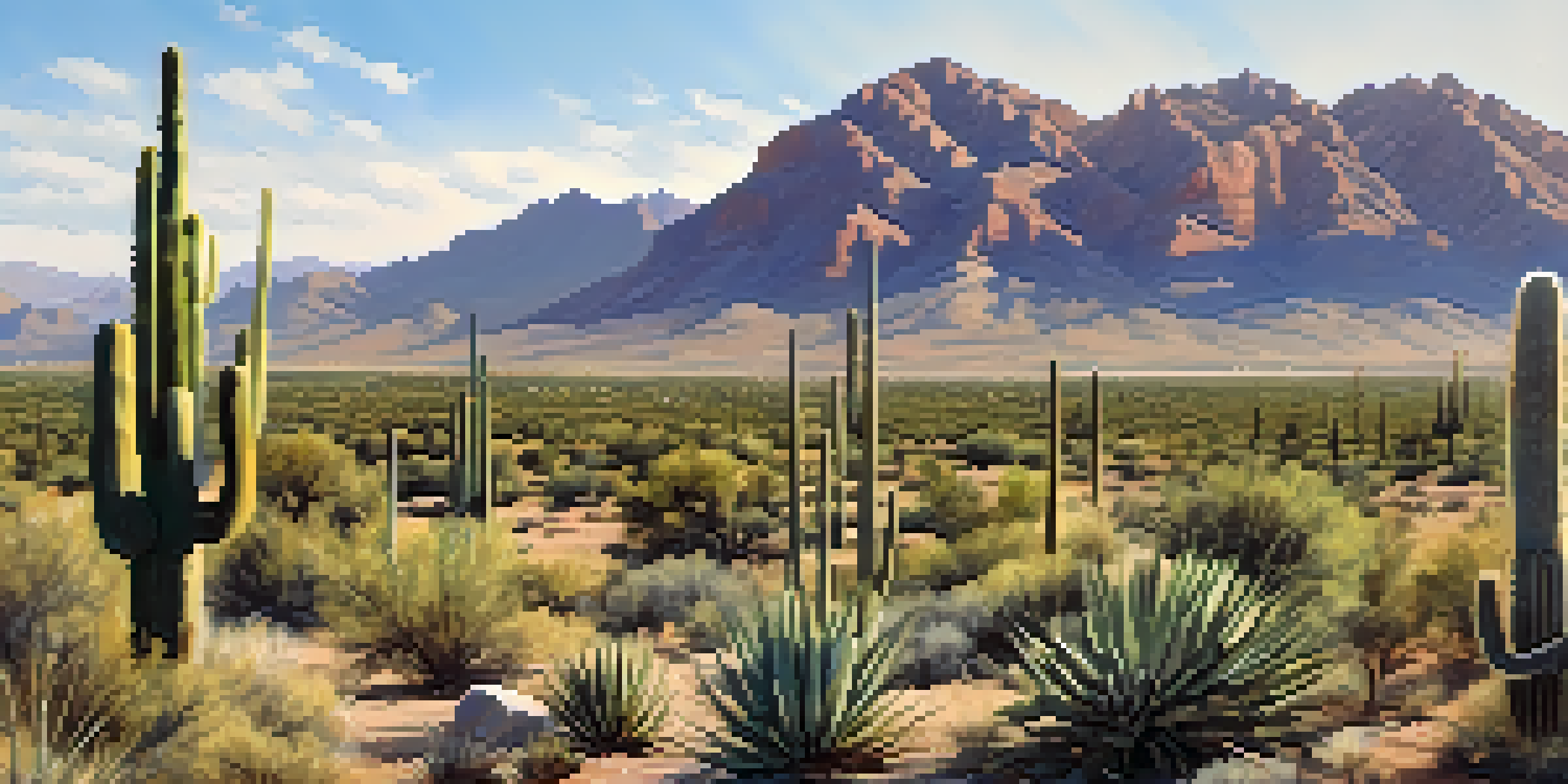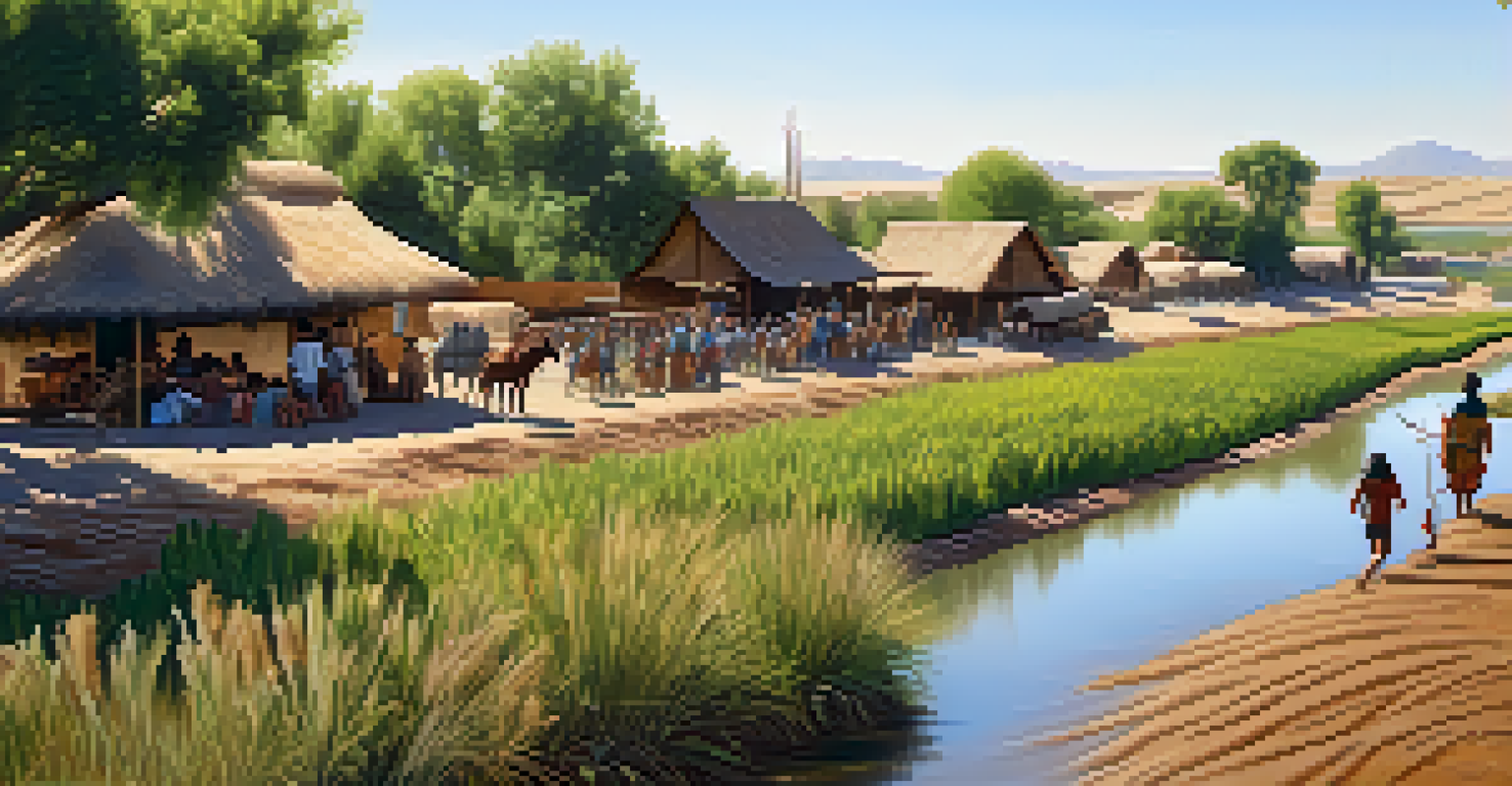The Influence of Tucson’s Geography on Native American Life

The Unique Landscape of Tucson and Its Tribes
Tucson is nestled in the Sonoran Desert, surrounded by picturesque mountains and valleys. This unique geography played a critical role in shaping the lives of Native American tribes, such as the Hohokam and Tohono O'odham. The diverse ecosystems offered various resources, from water sources to fertile land for agriculture, allowing these tribes to thrive.
The land is sacred. It is the source of our life and culture, and the foundation of our identity.
The region's mountains provided not just breathtaking views but also essential materials like stone for tools and shelter. The valleys and riverbeds were fertile grounds for growing crops, which were vital for sustenance and trade. In many ways, the natural landscape was akin to a supermarket for these tribes, offering everything they needed to support their communities.
Overall, Tucson's geography fostered a rich tapestry of life that was deeply intertwined with the land. The tribes learned to adapt their lifestyles to the environment, forming a harmonious relationship with it that would influence their culture, traditions, and survival strategies for generations.
Water Sources: Lifeblood of Native American Communities
In Tucson, water sources like the Santa Cruz River were crucial for survival. The river not only provided drinking water but also supported agriculture by irrigating crops. This access to water allowed Native American groups to develop advanced farming techniques, which were essential for their way of life.

The Hohokam, for instance, created an extensive system of canals to harness the river's flow, demonstrating remarkable engineering skills. This innovation enabled them to cultivate a variety of crops, including corn, beans, and squash, which formed the backbone of their diet. Their agricultural success contributed to population growth and the development of complex societies.
Tucson's Geography Shapes Tribes
The unique landscape of Tucson, with its mountains and rivers, provided essential resources that influenced the lifestyles and cultures of Native American tribes.
Furthermore, water sources were often seen as sacred, deepening the tribes' spiritual connection to the land. Rituals and ceremonies centered around water reflected its significance, emphasizing how vital it was to their cultural identity and community cohesion.
Desert Flora and Fauna: A Resourceful Environment
The Sonoran Desert is teeming with unique plant and animal life, which Native American tribes skillfully utilized. Cacti, such as the saguaro, provided food and materials for shelter, while the abundant wildlife offered hunting opportunities. The tribes developed an intricate understanding of their environment, learning to identify which plants were edible and which were medicinal.
In every walk with nature, one receives far more than he seeks.
For example, the saguaro fruit was harvested during the summer months, becoming an important food source. Additionally, tribes used the ribs of the saguaro for building materials and tools. This resourcefulness showcased their ingenuity and adaptability in a challenging landscape.
Moreover, the diverse ecosystem served as a classroom, teaching generations about sustainable practices and respect for nature. The close relationship with the land fostered a deep cultural connection that remains significant in Native American traditions today.
Seasonal Changes: Influencing Lifestyle and Movement
Tucson's geography results in distinct seasonal changes, which significantly influenced Native American life. The warm summers encouraged a focus on gathering and harvesting, while cooler months were often dedicated to hunting and preparing for the winter. This seasonal rhythm dictated the movements and activities of tribes throughout the year.
During the summer, tribes would gather at areas rich in resources, such as riverbanks or fruit-laden cacti. They would engage in communal activities, strengthening social bonds while ensuring everyone had enough to eat. Winter, on the other hand, prompted migration to more sheltered areas, demonstrating their adaptability to changing conditions.
Water: Essential for Survival
Access to water sources like the Santa Cruz River enabled tribes to develop advanced farming techniques, crucial for their sustenance and community growth.
This natural cycle instilled a profound respect for time and the environment, shaping cultural practices and traditions. Festivals and rituals often coincided with seasonal changes, emphasizing the tribes' connection to the land and its rhythms.
Trade Networks: Geography as a Connector
Tucson's strategic location made it a hub for trade among various Native American tribes. The surrounding mountains and desert created natural pathways that facilitated the exchange of goods, ideas, and culture. This interconnectedness fostered a vibrant trade network that enriched the lives of the tribes involved.
Items such as pottery, textiles, and food items were commonly traded, allowing tribes to share resources that might be scarce in their own regions. For instance, the Tohono O'odham were known for their baskets, which became sought-after trade items. This exchange not only provided practical goods but also helped build relationships between different tribes.
The trade routes were more than just pathways; they were lifelines that promoted cultural exchange and understanding. Over time, these interactions contributed to the development of a rich and diverse cultural heritage in the region.
Cultural Practices: Shaped by the Land
The geography of Tucson significantly influenced the cultural practices of its Native American tribes. Music, dance, and art often reflected the natural environment, drawing inspiration from the mountains, desert flora, and seasonal changes. These cultural expressions served as a means to connect with the land and honor its offerings.
For example, many traditional songs and dances celebrate the changing seasons or the bounty of the harvest. Festivals often coincided with important agricultural milestones, reinforcing the relationship between culture and environment. This deep-rooted connection is evident in the stories and teachings passed down through generations.
Cultural Practices Reflect Nature
The cultural expressions of Tucson's Native American tribes, including music and rituals, are deeply intertwined with the natural environment and seasonal changes.
Furthermore, spiritual beliefs were closely tied to the landscape. Many tribes viewed natural elements as sacred, incorporating them into their rituals and practices. This spiritual connection to the land reinforced a sense of identity and belonging, emphasizing the importance of geography in shaping their worldview.
Modern Impacts: Preserving Heritage Amidst Change
Today, Tucson's geography continues to impact Native American communities, particularly as they navigate modern challenges. Urban development and environmental changes pose threats to traditional lands and resources. However, many tribes are actively working to preserve their heritage while adapting to contemporary life.
Efforts to revitalize traditional agricultural practices and reclaim ancestral lands are critical components of this movement. By reconnecting with their roots, tribes aim to foster a sense of identity and community in a rapidly changing world. This resilience highlights the enduring influence of geography on their way of life.

Moreover, educational initiatives are helping to share Native American history and culture with broader audiences. By raising awareness about their rich heritage, these communities hope to foster respect and understanding, ensuring that the significance of Tucson's geography remains a vital part of their narrative.